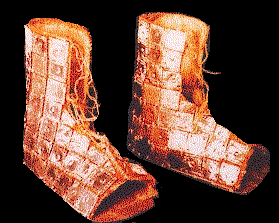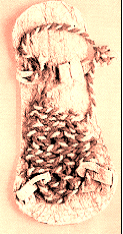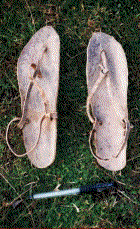« Arqueología »
Wearing shoes Prehispanic
( Spanish Version )
 Sporadically we receive references of some or another evidence of which can seen
the high aesthetic degree; of accord to the sociological factors of our culture
and which are allowed to see the influence of a high intellectual potential,
showing us the sensibility, manual dexterity, in the application and materials
employees in the observation among them: some private rooms for some families or
in special occasions.
Sporadically we receive references of some or another evidence of which can seen
the high aesthetic degree; of accord to the sociological factors of our culture
and which are allowed to see the influence of a high intellectual potential,
showing us the sensibility, manual dexterity, in the application and materials
employees in the observation among them: some private rooms for some families or
in special occasions.
The footwear of daily use or commonly well-known use as domestic presents elements in which confirm us, how the man adjusts with a lot of creativity to their homo; keeping in mind the controversial factors of the nature and the reality in that it was developed.
In relation with to the handmade elaboration of the footwear we have model natives from the most rudimentary until those where the talent and the creativity captured with sencilles the width of their knowledge, conjugating the wide approach of the technological domain on the diverse materials.
In the old Peru, the footwear varies of a place to depending of the area of location. Etnographically is known that at the present time still persists the use of some of these old model.
Formerly they was used it the town in general and the big gentlemen; today they persist in our highlands and proudly we can affirm that they are samples of that model of our past.
The nearest knowledge that we have of them comes mainly from the described information of the diverse files of the colonial time of documents like; testimonies, inheritances.
Among other contributions of this topic we have the papers of: Toribio Mejia Xesspe, Victor Pimentel and other investigators. Of the results of those contributions we have the identification of the "Ushuta", "Llanque", "Chapito", "Shuquy"and others as the"Seqoy" elaborated in such way that were good to cover the whole foot, being adjusted with a thin fiber which surrounded the instep and the superior part of the heel.
The"Pollqo" in its majority was good to warm, covering the foot of the cold five pesetas, for texture was adjusted to these requirements of first order.
 The prehispanic footwear varied to one region to another depending on the
available resources and of the existent abundance in each place being known that
the material that they used was of and animal origin in raw or weatherbeaten
leather; vegetable fibers, supplementing them with other additions.
The prehispanic footwear varied to one region to another depending on the
available resources and of the existent abundance in each place being known that
the material that they used was of and animal origin in raw or weatherbeaten
leather; vegetable fibers, supplementing them with other additions.
"Pollqo" is considered as a shoe or sport shoe in the time of the Inca of three varieties: elaborated with weatherbeaten skin conserving the natural coat of the auquénido or stag in some cases of marine wolf, having an edge in the superior part finished off by wool fabric or in some cases by cotton.
The other footwear type in its majority presents the elaboration in cabuya material (better known as maguey) or wool fabrics, cotton; being identified in some cases the elaboration of templates for braided of fibers.
The third footwear of this same type in its majority, was elaborated in raw leather, with two or more united pieces or with a leather tape that surrounded from one to two turns.
 Antecedents of these models have the pickups in the valley of Rimac, and others
with decoration found in valley from Ica with the style Chincha and with
filiation of the Inca culture.
Antecedents of these models have the pickups in the valley of Rimac, and others
with decoration found in valley from Ica with the style Chincha and with
filiation of the Inca culture.
The identificable denominations for the "Sukuy" it presents characteristic a sandal aspect, which was composed by a sole or raw leather. Whose peculiarity is of a fold that it covers the fingers and they allow that this it can be held to the foot by means of wide straps crossed alternating in diagonal over the vamp pressing it in a way more stabilized.
The "Seqoy" also considers in the sandal type, but elaboration in its majority manufactured with skin, being proceeded to maintain the wool; in its majority elboradas with remains of llama skin, or another ruminant related. Having this the peculiarity of covering the border and contour of the fingers and sides of the foot, it was held also with a cord of vegetable fiber or a thin tape of leather.
 Previous page
Previous page